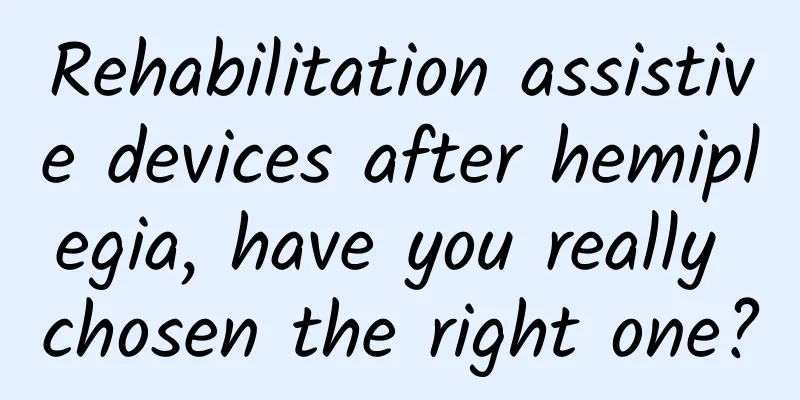Rehabilitation assistive devices after hemiplegia, have you really chosen the right one?

|
Have you really chosen the right rehabilitation aids for hemiplegia? Hemiplegic patients may face various obstacles in their daily lives. Choosing the right rehabilitation aids can not only help restore physical functions, but also improve the quality of life. However, there are many types of assistive devices on the market, and incorrect selection may result in less than satisfactory results. This article will start from common problems and help you scientifically select rehabilitation aids for hemiplegic patients. What is hemiplegia? Hemiplegia, also known as half of the body paralysis, refers to the movement disorder of the upper and lower limbs, facial muscles and lower part of the tongue muscles on one side. It is a common symptom of acute cerebrovascular disease. Although patients with mild hemiplegia can still move, they often walk with their upper limbs bent and their lower limbs straight. The paralyzed lower limbs make a half circle with each step. We call this special walking posture hemiplegic gait. Severe cases are often bedridden and lose their ability to live. Although patients with mild hemiplegia can still move, they often walk with their upper limbs bent and their lower limbs straight. The paralyzed lower limbs make a half circle with each step. We call this special walking posture hemiplegic gait . Severe cases are often bedridden and lose their ability to live. Classification of hemiplegia 1. Complete hemiplegia It refers to the paralysis of the central facial nerve, hypoglossal nerve and upper and lower limbs on one side. The degree of paralysis is complete and the muscle strength is zero. 2. Incomplete hemiplegia It refers to the paralysis of the central facial nerve, hypoglossal nerve and upper and lower limbs on one side. The degree of paralysis is complete and the muscle strength is zero. 3. Equal hemiplegia It refers to the equal degree of central facial nerve paralysis, central hypoglossal nerve paralysis and central upper and lower limb paralysis on one side of the body. Regardless of whether it is complete hemiplegia or incomplete hemiplegia, the degree of paralysis of these three parts is always equal. 4. Unequal hemiplegia Refers to the unequal degree of central facial nerve paralysis, central hypoglossal nerve paralysis, central upper limb paralysis and central lower limb paralysis. It is a characteristic of subcortical white matter lesions. The uneven hemiplegia that occurs is also different depending on the location of the lesion. Common functional impairments caused by hemiplegia 1. Movement disorders The most common symptom is paralysis of one side of the limbs. In severe cases, the paralyzed limb cannot move autonomously, loses sensation, and has no muscle strength. In milder cases, the muscle strength of the paralyzed side is reduced, making it difficult to move. 2. Sensory impairment Mainly manifested as impairment of pain, temperature, touch, pressure, vision, etc. 3. Cognitive impairment The patient's memory, analytical ability, and thinking ability are significantly reduced, and his reaction is slow. In severe cases, he suffers from apraxia and agnosia and is unable to perform his previous work. Recommended rehabilitation aids for hemiplegia 1. Walking assistance Walker: Suitable for patients with poor balance or weak lower limb muscle strength, providing stable support and helping walking. Crutches: Common in patients with unilateral lower limb weakness or instability, divided into axillary crutches and single crutches. Ankle-foot orthosis (AFO): prevents ankle flexion, inversion, Achilles tendon contracture, hip external rotation and other functional disorders caused by long-term bed rest. 2. Hand function rehabilitation Finger separation board: used to prevent and improve finger flexion contracture. Wrist-hand orthosis: It prevents the occurrence of joint deformities such as finger flexion and wrist flexion due to high flexor muscle tension in the upper limbs, and also prevents edema of the upper limbs. 3. Daily life assistance Pickup Sock Putting Device Eating chopsticks Grip Spoon Anti-spill bowl Buckle fastening aid Anti-pressure sore pad Commonly used anti-pressure sore pads can be divided into wheelchair cushions, anti-pressure sore cushions, position cushions, anti-pressure sore mattresses, etc. according to different application scopes. They have various shapes and styles, and are mainly used for long-term sitting and lying patients to adjust their body positions and maintain correct postures, so as to prevent pressure sores and prevent joint deformation and spasms. Reasonable intervention of rehabilitation assistive devices for hemiplegic patients can significantly improve their quality of life and functional recovery effects, but when choosing assistive devices, they must be customized according to their own conditions and jointly evaluated by doctors, therapists and rehabilitation engineers to ensure the safety and adaptability of the assistive devices. Do not buy blindly to avoid new health problems or delays in the rehabilitation process due to inappropriate assistive devices. -END- |
<<: Revealing the secrets of craniotomy, is it really as scary as imagined?
>>: What should you pay attention to when caring for bedridden patients?
Recommend
Can I eat raw dates after abortion?
Getting pregnant but not being able to give birth...
What to do if you have spots during pregnancy
Pregnancy is a very difficult thing for women. Du...
Why does it hurt when a man sucks his nipples?
When lovers are doing naughty things, if the woma...
Pregnancy signs that must appear in one month
In TV dramas, there are often scenes where women ...
Regulations for pregnant women flying
Pregnant women can take a plane. If you need to t...
Can babies take hormone drugs?
Review of the hormone cream incident: After a par...
Why does leucorrhea smell sour?
The leucorrhea has a sour smell, so women should ...
Every woman must guard these five "holes"
The incidence of vaginitis is very high, and now ...
Cervical tct screening
Cervical TCT screening is a common examination me...
What is the significance of the central bank's digital currency? Introduction to the central bank's digital currency and its issuance time
Digital currency can be understood as the digitiz...
When will the new mutants be released in China? Download the new mutants movie in high definition with Thunder
The New Mutants is a movie that everyone has been...
What are the dangers of thick endometrium?
A thin endometrium is not good for women. Similar...
Is it true that the flu can trigger an asthma attack?
In recent years, influenza has appeared early eve...
Do polar bears hibernate? How do polar bears spend the winter?
The polar bear is an animal of the Ursidae family...
Is 2.0cm of pelvic fluid serious?
Pelvic effusion is a condition that occurs in man...






![[Breaking news] The National Health Commission has released a new epidemic prevention and control plan, with more changes than the previous eight versions!](/upload/images/67f1edd14bdaa.webp)


